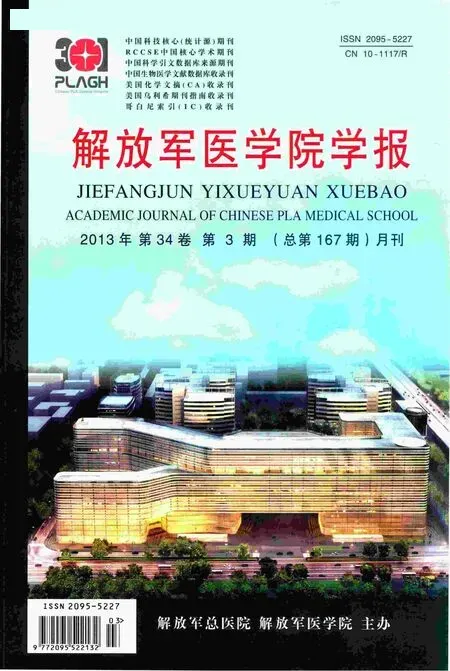青少年特发性脊柱侧弯患者影像学锁骨水平的临床意义
唐翔宇,张永刚,郑国权,施新革,赵永飞,张国莹,张雪松,崔 庚
解放军总医院 骨科专科医院脊柱外科,北京 100853
青少年特发性脊柱侧弯(adolescent idiopathic scoliosis,AIS)患者中轴骨骼脊柱的畸形致使肩部平衡情况发生变化。而肩部平衡情况是影响患者自身满意程度最重要的因素之一[1-5]。目前,锁骨水平作为常用的肩部影像学参数,对脊柱外科医生全面衡量患者畸形状况、评估治疗效果有着重要参考意义[6-10]。既往研究均通过锁骨水平与肩高的相关性,评价其临床价值[11-12]。但在临床应用中,影像学参数预测的有效性更值得评估。本研究将反映双侧锁骨倾斜程度的锁骨角(clavicle angle,CA)和反映双侧锁骨差异的锁骨差(clavicle difference,CD)同时纳入分析,全面了解锁骨水平对评估AIS患者肩部畸形的临床意义。
对象和方法
1 对象 选取2010年6月-2011年12月在我院接受治疗的连续120例主胸弯AIS患者。排除标准:肩部肿物,既往脊柱、肩部外伤及手术者。其中女性92例,男性28例,平均年龄14.6岁。所有患者均行自然站立后前位脊柱全长X线片及肩背部外观照。
2 参数测量 分别量取锁骨角、锁骨差、外观肩高参数。锁骨角(CA):双侧锁骨最高点连线与水平面的夹角(图1)[6]。锁骨差(CD):双侧锁骨最高点的垂直高度差值(图2)。外观肩高(ASD):即邱旭升等所定义的外肩高,自背部两侧最高腋引水平线,交左右上臂于P、Q,引颈部中线交PQ于G,自PG、GQ的外三等分点E、F引垂线交肩部上缘于A、B,自A、B所引水平线的垂直高度差值为外观肩高(图3)[11]。所有参数左侧较右侧抬高为正,反之为负。
3 参数差异评价 根据即往研究[6,13-14]:肩高≥1.0 cm为双肩高度有差别(即双肩不平衡),双肩高度差值≥2.0 cm且<3.0 cm为双肩高度有明显差别(即双肩中度不平衡),双肩高度差值≥3.0 cm为双肩高度有较大差别(即双肩重度不平衡)。锁骨差与外观肩高差绝对值为d,设d≥1.0 cm两肩部参数值存在差别,2.0 cm≤d<3.0 cm两肩部参数值有明显差别,d≥3.0 cm两肩部参数值有较大差别。
4 统计学处理 采用SPSS16.0统计软件,对锁骨角、锁骨差分别与外观肩高进行Person相关分析;对锁骨差与外观肩高的参数间差值绝对值进行统计学描述;以外观肩高≥1.0 cm为双肩不平衡标准[6,13],通过受试者工作特征曲线(ROC曲线)对锁骨水平诊断肩部平衡与否的准确性进行评估,评估指标为ROC曲线下面积(AUC),同时选择最佳截距点,确定最大约登指数,以及取最佳截距点时的敏感度、特异度。P<0.05为差异有统计学意义。
结 果
1 参数范围 120例患者的肩部参数值范围均包含正值与负值:锁骨角(°)-5.46~18.50,锁骨差(cm)-2.79~3.63,外观肩高(cm)-2.32~3.09,见表1。
2 锁骨水平与外观肩高相关性 锁骨差与外观肩高相关,r=0.86(P<0.05);锁骨角与外观肩高相关,r=0.73(P< 0.05)。
3 锁骨差与外观肩高差值 绝对值d(-x±s;95%CI)为(0.57±0.52;0.47~0.66);锁骨差与外观肩高有差别者(d≥1.0 cm)12例(10.0%),有明显差别者(2.0 cm≤d<3.0 cm)3例(2.5%),无d≥3.0 cm病例,见图4。
4 诊断价值评估 以外观肩高≥1.0 cm为双肩不平衡标准,应用锁骨角诊断肩部平衡与否时,ROC曲线下面积为0.786±0.043(<0.90),最大约登指数为0.50,取最佳截断点时的敏感度为0.750、特异度为0.750;应用锁骨差诊断肩部平衡与否时,ROC曲线下面积为0.754±0.044(<0.90),最大约登指数为0.44,取最佳截断点时的敏感度0.632、特异度0.808,见表2。

表1 锁骨水平参数及外观肩高测量结果Tab.1 Clavicle balance parameters and shoulder height

表2 肩部锁骨水平诊断肩部平衡的ROC曲线分析结果Tab.2 ROC curve for the diagnosis of clavicle balance
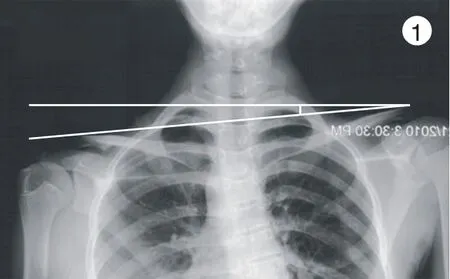
图1 锁骨角Fig.1 Clavicle angle
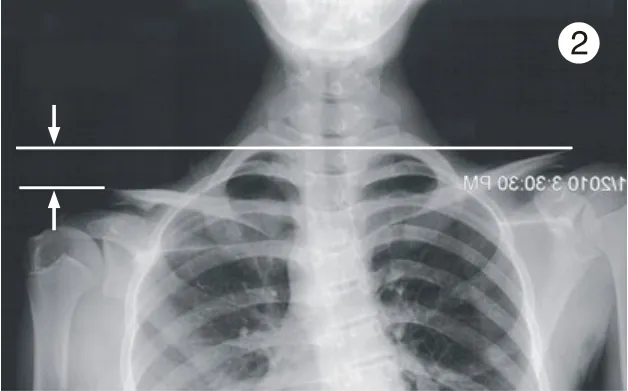
图2 锁骨差Fig.2 Clavicle difference
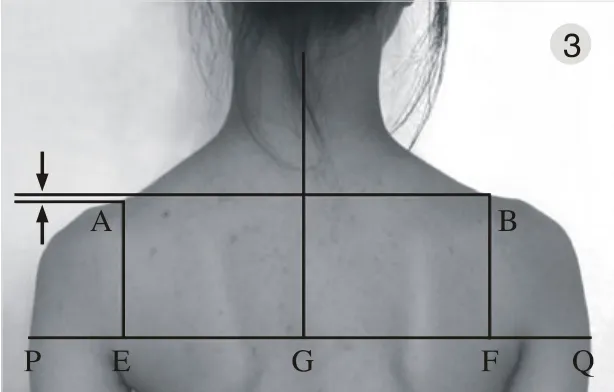
图3 外观肩高Fig.3 Shoulder height
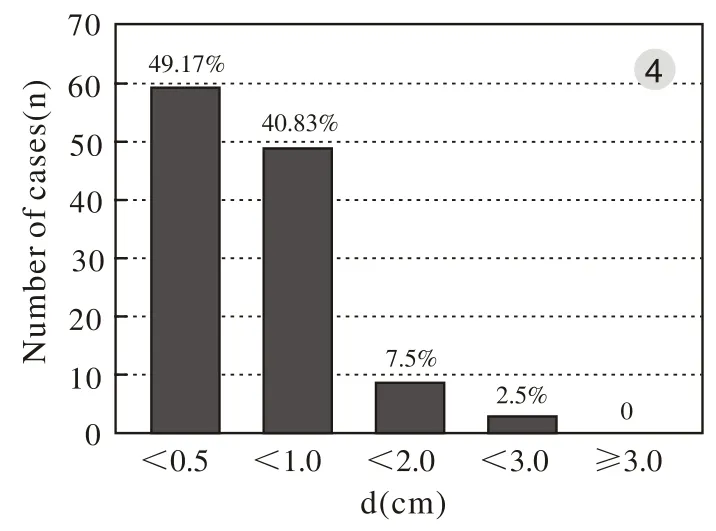
图4 外观肩高-锁骨差 参数间差异(d, cm)统计图Fig.4 Differences in shoulder height and clavicle difference(d, cm)
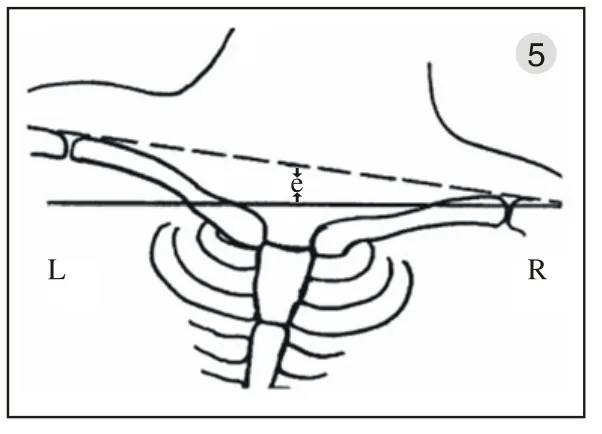
图5 Kuklo等定义的锁骨角Fig.5 Clavicle angle defined by Kuklo et al
讨 论
青少年特发性脊柱侧弯患者的肩部平衡是脊柱科医师较为关注的临床指标,也是评估患者畸形程度及治疗效果的重要标准[15-17],而影像学参数锁骨水平对评估肩部平衡情况有重要的临床意义[6-10]。Kuklo等定义锁骨角为双侧锁骨最高点连线与水平面的夹角(图5),并以其作为衡量肩部平衡的参数[6]。但Akel等对健康青少年肩部平衡的研究显示,锁骨角与临床肩高不具有极高的相关性[12]。邱旭升等认为双胸弯AIS患者中,目前为止包括锁骨角在内的影像学参数与肩部外观参数相关系数均<0.80[11]。
本研究中,锁骨差与锁骨角均取双侧锁骨最高点进行比较,仅计量方式有所不同。锁骨差的计量方式与外观肩高一致,均为两点垂直高度差即线段长度,较倾斜角与外观肩高有更高的相关性,相关系数>0.80,提示锁骨差与外观肩高存在极高相关性,较国内外学者研究结果更为乐观。因此,在既往研究中,可能存在因参数间数学计量方式的不一致而产生研究结果的差异。
临床实践中,虽然锁骨差与肩高存在极高的相关性,但锁骨差与外观肩高的参数值不一致率较大,甚至部分研究对象参数值存在着明显差别,说明锁骨水平在反映肩部平衡情况上不具有较高的准确性,通过影像学参数锁骨水平尚不能较准确预测真实肩高。
肩部平衡与否是影响患者及家属满意程度的重要因素,也是医生手术成功与否的重要标准。在应用ROC曲线对影像学锁骨水平诊断价值的评估中,ROC曲线下面积<0.90,提示锁骨水平诊断肩部平衡与否不具准确诊断价值。脊柱科医师需通过其他资料全面了解患者肩部畸形情况。
本研究仅限于外科医生关注的参数,而对外观美学要求较高的AIS患者对肩部平衡情况的评价未考虑;所研究的影像学资料及外观资料采集过程中,均要求患者保持自然站立位,但两种资料采集是在不同时间、不同地点进行,未能避免两者站立状态可能存在的差别。
1 Climent JM, Reig A, Sánchez J, et al. Construction and validation of a specific quality of Life instrument for adolescents with spine deformities[J]. Spine (Phila Pa 1976), 1995, 20(18): 2006-2011.
2 Asher M, Min Lai S, Burton D, et al. The reliability and concurrent validity of the scoliosis research society-22 patient questionnaire for idiopathic scoliosis[J]. Spine (Phila Pa 1976), 2003, 28(1):63-69.
3 Bridwell KH, Shufflebarger HL, Lenke LG, et al. Parents' and patients' preferences and concerns in idiopathic adolescent scoliosis:a cross-sectional preoperative analysis[J]. Spine(Phila Pa 1976), 2000, 25(18):2392-2399.
4 Smith PL, Donaldson S, Hedden D, et al. Parents' and patients'perceptions of postoperative appearance in adolescent idiopathic scoliosis[J]. Spine (Phila Pa 1976), 2006, 31(20): 2367-2374.
5 Sanders JO, Polly DW Jr, Cats-Baril W, et al. Analysis of patient and parent assessment of deformity in idiopathic scoliosis using the Walter Reed Visual Assessment Scale[J]. Spine (Phila Pa 1976),2003, 28(18): 2158-2163.
6 Kuklo TR, Lenke LG, Graham EJ, et al. Correlation of radiographic,clinical, and patient assessment of shoulder balance following fusion versus nonfusion of the proximal thoracic curve in adolescent idiopathic scoliosis[J]. Spine (Phila Pa 1976), 2002, 27(18):2013-2020.
7 Suk SI, Kim WJ, Lee CS, et al. Indications of proximal thoracic curve fusion in thoracic adolescent idiopathic scoliosis: recognition and treatment of double thoracic curve pattern in adolescent idiopathic scoliosis treated with segmental instrumentation[J]. Spine (Phila Pa 1976), 2000, 25(18): 2342-2349.
8 Cil A, Pekmezci M, Yazici M, et al. The validity of Lenke criteria for defining structural proximal thoracic curves in patients with adolescent idiopathic scoliosis[J]. Spine (Phila Pa 1976), 2005, 30(22):2550-2555.
9 Matsumoto M, Watanabe K, Ogura Y, et al. Short Fusion Strategy for Lenke Type 1 Thoracic Curve Using Pedicle Screw Fixation[J]. J Spinal Disord Tech, 2011. [Epub ahead of print]
10 Zhao Y, Wang Z, Zhu X, et al. Prediction of postoperative trunk imbalance after posterior spinal fusion with pedicle screw fixation for adolescent idiopathic scoliosis[J]. J Pediatr Orthop B, 2011, 20(4):199-208.
11 Qiu XS, Ma WW, Li WG, et al. Discrepancy between radiographic shoulder balance and cosmetic shoulder balance in adolescent idiopathic scoliosis patients with double thoracic curve[J]. Eur Spine J, 2009, 18(1): 45-51.
12 Akel I, Pekmezci M, Hayran M, et al. Evaluation of shoulder balance in the normal adolescent population and its correlation with radiological parameters[J]. Eur Spine J, 2008, 17(3): 348-354.
13 Kuklo TR, Lenke LG, Won DS, et al. Spontaneous proximal thoracic curve correction after isolated fusion of the main thoracic curve in adolescent idiopathic scoliosis[J]. Spine (Phila Pa 1976), 2001,26(18): 1966-1975.
14 Smyrnis PN, Sekouris N, Papadopoulos G. Surgical assessment of the proximal thoracic curve in adolescent idiopathic scoliosis[J]. Eur Spine J, 2009, 18(4): 522-530.
15 Theologis TN, Jefferson RJ, Simpson AH, et al. Quantifying the cosmetic defect of adolescent idiopathic scoliosis[J]. Spine (Phila Pa 1976), 1993, 18(7): 909-912.
16 Iwahara T, Imai M, Atsuta Y. Quantification of cosmesis for patients affected by adolescent idiopathic scoliosis[J]. Eur Spine J, 1998,7(1): 12-15.
17 Raso VJ, Lou E, Hill DL, et al. Trunk distortion in adolescent idiopathic scoliosis[J]. J Pediatr Orthop, 1998, 18(2): 222-226.

